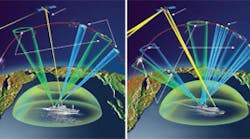David Washburn and Wayne Risas, Raytheon Co.
| Legacy Cobra Judy | Cobra Judy Replacement | |
| Sensors | S-band phased array X-band dish | S-band phased array X-band phased array |
| Search | S-band | S-band (primary) X-band (secondary) |
| Precision range track | X-band | X-band (primary) S-band (secondary) |
| S-band data collection | Multiple simultaneous objects | Multiple simultaneous objects |
| X-band data collection | Single objects sequentially | Multiple simultaneous objects |
Cobra Judy was developed in the 1970s to provide the government with long-loiter, ballistic-missile data-collection capability in support of international-treaty monitoring activities. Its precision data-collection system comprises two radars, both of which were designed and built by Raytheon: an S-band, computer-driven, passive phased-array radar and an X-band dish radar. The Cobra Judy (CJ) radar system has been operational since 1981, when it was installed on board the T-AGM-23 ship USNS Observation Island (OBIS). For the past 30 years, the Cobra Judy radars have been the premier national collectors of radar data on ballistic missiles. On average, the OBIS deploys 270 days per year.
Clearly, the Cobra Judy radars have significantly exceeded their original 10-year life expectancy. After more than three decades of use, however, the cost to maintain the radars and the ship (converted from a merchant ship originally launched in 1953) makes Cobra Judy unsustainable. It is therefore planned to leave service in the near future. The Cobra Judy legacy will continue, however, with the new Cobra Judy Replacement (CJR) radar system. That system is currently undergoing shipboard integration and testing by Raytheon on board the T-AGM-25 ship USNS Howard O. Lorenzen.
CJ Versus CJR: Technology Scope
In late 2003, Raytheon was awarded a contract by the US Navy to develop the CJR mission equipment (CJR ME). It is now leading an industry team, which includes Northrop Grumman Electronic Systems, General Dynamics SATCOM Technologies, and Kiewitt Offshore Services (KOS). The T-AGM-25 ship was built for the Navy by VT Halter Marine. The CJR mission is unchanged from that of the current CJ system. Due to the advanced technology that it employs, however, the new CJR dual-band radar suite provides significantly increased mission capability (see table).
The legacy CJ S-band radar is a tube-based passive phased array, which can be mechanically positioned in azimuth only. The CJ X-band radar utilizes a dish antenna to track single objects sequentially. The legacy CJ system performs search functions using only the S-band radar and track functions using only the X-band radar.
CJR is the first fully integrated, dual-band, ship-based, active phased-array radar system. The CJR ME data-collection system comprises three main elements: the X-band front end (XFE), the S-band front end (SFE), and the common back end (CBE). For CJR, both the Raytheon X-band and Northrop Grumman S-band antennas employ active-electronically scanned-array (AESA) technology. They are capable of performing search, track, and data collection on multiple simultaneous objects.
The primary mission of the SFE is to autonomously search, acquire, and track objects of interest. Its secondary mission is to collect medium-resolution data as required. In contrast, the primary mission of the XFE is to provide wideband, high-resolution data on objects of interest according to an automated, user-defined profile. Its secondary mission is to provide autonomous search, acquisition, and track capability to augment the SFE. The dual-band architecture allows optimal flexibility in an operational environment, as both SFE and XFE can perform multiple roles and hand off tracks (see figure).
Both the SFE and XFE antennas can be mechanically positioned in azimuth and elevation to maximize sensitivity in various sea state conditions, ship heading changes, and object movement during a mission. These missions require the use of selectable wideband waveforms, precise beam position control, and highly accurate measurement capability. Due to the complexity of a typical mission, the fully automatic data-collection sequence is user-profile-controlled based on selected real-time measurements and pre-defined event triggers. The large aperture, high power, and low-noise performance of the SFE and XFE antennas provide excellent radar sensitivity. Both radars also have improved reliability, due to the graceful degradation inherent in active phased arrays.
The advantages of the CJR system include the following:
- Expanded search, track, classification, and data-collection quantity and quality.
- Enhanced reliability and reduced life-cycle costs.
- Tracking and data collection on boosting objects.
- Maintaining track on both spent boosters and deployed objects.
- More robust object-classification processing.
- Increased bandwidth and pulse-repetition frequencies.
- Improved data quality in both range and doppler resolution.
- Operators are provided critical data in near real time.
- All waveforms are pulse-compressed (processed for analysis) in real time.
Development of the CJR Mission Equipment design was completed this past February with the delivery of the S-band array from Northrop Grumman to KOS. The massive, X-band and S-band active phased-array antennas were installed onto the ship in the summer of 2011, using carefully planned multiple crane lifts. All the mission equipment is now installed onto the ship. The program is proceeding on plan with dual-band integration. Initial operational capability is planned for 2013.
David Washburn
Program Manager
Cobra Judy Replacement
Raytheon Integrated Defense Systems
Wayne Risas
Chief Engineer
Cobra Judy Replacement
Raytheon Integrated Defense Systems

